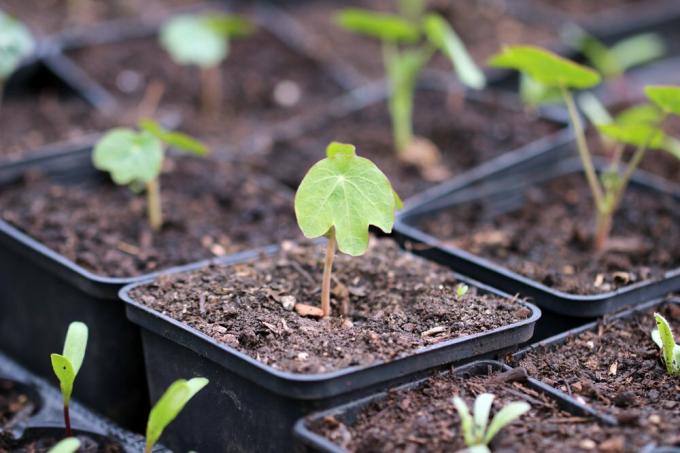
table of contents
- time
- Location
- Cultivation in a pot
- Plant nasturtiums
- Suitable plant partners for Tropaeolum
The orange, red, yellow, and more rarely pink or black glowing flowers of the nasturtium are responsible not only for color in the garden or on the balcony, but also enrich salads, soups or Desserts. In addition, Tropaeolum makes hardly any demands on maintenance. In order for the climbing plant to grow well, however, the time of sowing is important. This guide provides the gardener with valuable tips on the date and procedure for planting out.
time
Unfortunately, the nasturtium is not frost-hardy, which is why sowing outdoors is only possible from mid-May after the ice saints. It is therefore advisable to grow young plants on the windowsill or in a greenhouse as early as March.
Location
If you want to sow nasturtiums yourself, you should definitely consider the later dimensions that the plant will assume. As a climbing plant, it forms long shoots that can be up to several meters long. For this reason, a climbing aid is urgently required. If you choose a balcony as the location, you can let the shoots entwine around the railing. Otherwise, the plant feels in good hands on a house wall.
Note: If there is little space, we recommend small-stature varieties that are ideally suited for the tub. In terms of the flowers, they are in no way inferior to their climbing conspecifics.
Cultivation in a pot
The gardener should choose a bright location for cultivation in pots. However, direct sunlight should be avoided. The delicate roots cannot yet compensate for the strong evaporation caused by the intense heat. A pane of glass is also recommended, which provides some warmth and promotes germination. The optimal temperature is 15 ° C to 18 ° C.
Note: The seeds of the nasturtium are surrounded by a hard shell. By soaking them in warm water or chamomile tea for about five hours before sowing, the gardener shortens the germination time.
The seeds of the climbing plant are comparatively large. The gardener can add them to the nursery pots individually or in pairs. But he should not sow more than two seeds.
instructions
- Fill pots with conventional seed soil or unfertilized coconut fibers
- Drill holes about 3 cm in size and up to 2 cm deep in the earth
- Place seeds in the substrate at a distance of 20 to 30 cm
- the plant is one of the dark germs, so cover it well with soil
- Keep the substrate constantly moist
- Cover the pots with a transparent plastic sheet
- Ventilate daily to prevent mold
- the first seedlings appear after 10 to 20 days

Note: Since the nasturtium is not hardy, sowing has to be done every year. It is true that wintering is possible in a frost-free, light location, but due to the climbing habit, the appropriate space is often not available.
Plant nasturtiums
If night frosts are no longer to be expected in May, the young plants can move to their permanent location outdoors. Before planting out, the gardener should wait for the ice saints. As already mentioned, sufficient space is relevant for the choice of location. The gardener should plant individual plants at least 30 to 50 cm apart. If, on the other hand, he decides to keep it in a bucket, he should put a maximum of two or three plants in a pot.
In addition, the soil conditions play a major role in terms of development. The climbing plant prefers calcareous, sandy loam soil. Conventional garden soil is just as suitable. As before, hardly any nutrients are required. Colorful flowers develop on poor soils, while the plant also thrives well on humus soil, but mainly forms leaves. An important rule for the application of fertilizer can be derived from this: too much fertilizer inhibits flower growth and, on the other hand, promotes foliage formation. A little organic compost in the spring will do just fine.
Suitable plant partners for Tropaeolum
The sharp, spicy aroma of the nasturtium flowers cannot be combined into an ideal composition on the plate. Even in the vegetable patch, the flowering plant harmonizes with numerous types of vegetables:
- Beans
- Cucumber
- peas
- radish
- tomatoes
